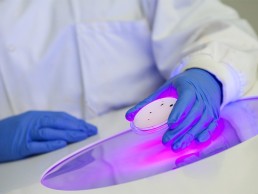
Linea Light Group collaborates with University of Strathclyde on antibacterial light source
(Italy) – Manufacturer’s new Environment Care Lighting range uses HINS light developed by Scottish university.
Linea Light Group has unveiled a new antibacterial technology range that could help to decontaminate surfaces and prevent infection.
The new Environment Care Lighting technology range uses High Intensity Narrow Spectrum (HINS) light, developed and patented by the University of Strathclyde in Glasgow, Scotland. The range enables the Woofer and Rollip appliances from Linea Light Group’s i-Lèd Professional collection to decontaminate surfaces and prevent infection, destroying up to 70-80% of bacteria with continuous use.
By using a light wavelength of 405nm, the Environment Care Lighting range can both light and decontaminate rooms, potentially avoiding the need for more expensive ultra-violet technologies that use frequencies between 240-260nm, require rooms to be empty during disinfection, and can cause degradation effects on photosensitive materials.
The action of two light sources – a violet-blue dominated LED combined with a white LED – enables the Environment Care Lighting technology to offer both lighting and disinfection at the same time.
The HINS-light technology was developed in the Robertson Trust Laboratory for Electronic Sterilisation Technologies (ROLEST) at the University of Strathclyde, thanks to the work of a team of experts led by Professor Scott MacGregor, Vice-Principal of the University, with Professor John G. Anderson, Dr Michelle Maclean and Professor Gerry Woolsey.
Linea Light Group will be the first European company to use the HINS-light patent in combination with lighting appliances, and looks to offer these fixtures for offices and public spaces, hospitals and healthcare settings, residential areas and multi-purpose buildings.
Gianluca Salciccia, Linea Light Group Sales Director, said: Linea Light Group’s products and projects put people in the spotlight. Lighting technology can be an important tool for wellbeing and improving people’s quality of life. Linea Light Group’s new Environment Care Lighting light range could also add a third dimension of physical wellbeing, with products capable of decontaminating the environments in which people live and work, protecting their health.”
Professor John G. Anderson, Research Fellow in Electronic & Electrical Engineering at the University of Strathclyde and member of the HINS-light technology research team added: “The Environment Care Lighting represents a unique method of disinfection as it does not employ harmful chemicals or dangerous UV light, but instead uses only visible light that is harmless to humans.
“The system works by using selected visible wavelengths that activate light sensitive molecules contained within microbes. This process creates biocidal chemicals that are lethal to bacteria such as MRSA or C.diff. The process can be operated continuously to achieve whole room disinfection in both the presence and absence of occupants.”
Professor Scott MacGregor added: “The technology is harmless to people, so it can be used continuously in different spaces, thus improving disinfection and preventing the spread of infection. Linea Light Group’s new Environment Care Lighting products means that many more people in healthcare, public spaces and in commercial, work and residential environments can benefit from this technology.”



